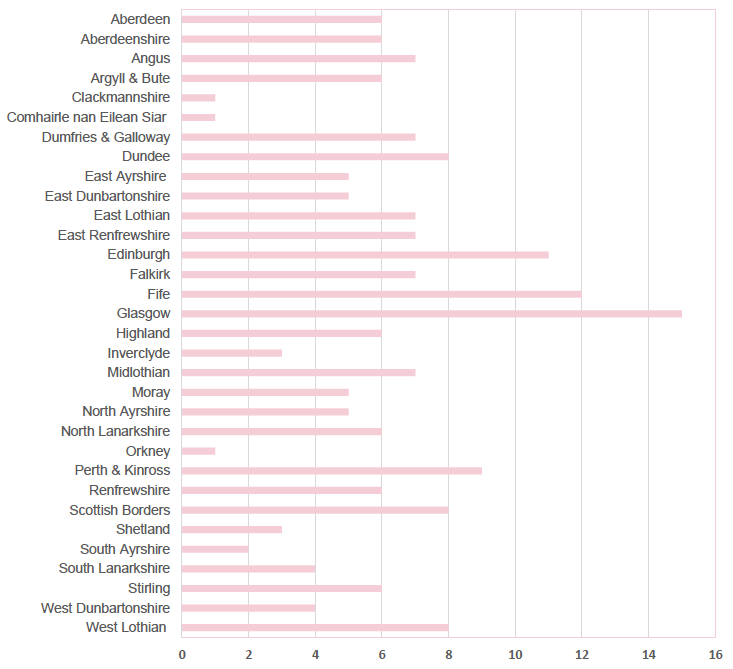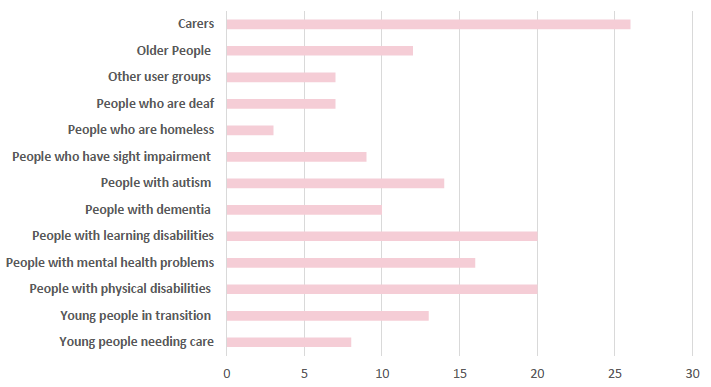Independent information and support services funded by the Scottish Government: review findings
Findings from a commissioned review of independent information and support services in relation to self-directed support for social care, in 2017.
2. Overview of the SIRD Projects
This chapter considers the profile of SIRD projects and with whom they have been working.
Profile of the projects
The SIRD funding programme began in 2012, with 42 organisations funded during the first three-year phase. [4] A second round of three-year funding began in April 2015 and runs to the end of March 2018. Over its six-year period, £12.7 million has been given to third sector organisations through the Scottish Government’s SIRD fund. [5] In total 36 organisations have been funded through the second round, receiving £2.96 million between them in the 2017/18 financial year. The levels of annual funding to each project in the second round have ranged from around £29,000 to around £129,000.
Performance monitoring of the SIRD projects is overseen by an external partner, Inspiring Scotland, who work to build third sector capacity, resilience and sustainability. [6] Inspiring Scotland publish annual reports and provide 6-monthly overview reports of project activity.
Figure 1 sets out the number of SIRD projects working in each local authority area. The local authorities in which the highest number of projects is operating are Glasgow, Edinburgh and Fife (15, 12 and 11 projects respectively). Those with the smallest number - only one project in each area - are Clackmannanshire, Comhairle nan Eilean Siar and Orkney. Orkney is also the only local authority area in which there are no SIRD projects involved in the delivery of information and support to members of the public.
Nine of the projects which provide information or support to members of the public work in one local authority area only. The others have a regional or national focus.
Figure 1: SIRD Projects by local authority

Other points to note about the SIRD projects include. [7]
- Seven of the projects have not been carrying out direct delivery of information and support. These have been focusing on work around capacity building, awareness raising and development of practice or materials.
- Overall, the SIRD projects have reported working with over 300 organisations and around 9,900 members of the public during the first two years of the second funding period (2015/16 and 2016/17). Further information on the particular activities undertaken is set out in the subsequent chapters.
Figure 2 shows that SIRD projects are working across a broad range of client groups, with the most frequent being carers (26 projects), people with learning difficulties (20 projects) and people with physical impairments (20 projects). People who are homeless is the least frequently worked with group (three projects). There are seven projects which work across all client groups.
Figure 2: Number of projects working with client groups [8]

Figure 3 sets out the age profile of the service users that SIRD projects have been working with, and provides comparative data taken from the most recent national statistics for 2015-16 (Scottish Government 2017).
Figure 3: Ages of SIRD project users and all making a choice about their social care budget

Although it should be noted that the SIRD service user group includes some people without a social care budget, the difference in the age profiles is nevertheless notable. Compared to all social care clients who made a choice about services, SIRD project users tend to be younger. In particular, SIRD projects were working with a relatively high number of those aged 17 or under and in the 18 to 64 age group, and a relatively small number of those aged 65 or over.
This younger age profile of SIRD service users may, to some extent, reflect the profile of those choosing Option 1. As noted above and discussed further below, many of those the SIRD projects have been supporting have been using Option 1. The national statistics highlight that the self-directed support options chosen vary according to client age group (Scottish Government 2017). In particular, older people are much more likely to choose Option 3 while younger people are relatively more likely to choose Option 1. Parents of young people (aged under 18), are also more likely to choose Option 1.
As noted earlier, there is very limited other information available about the profile of SIRD project service users. More granular monitoring information, for example capturing service users’ gender, ethnicity, socio-economic circumstances or assessed need would allow for more detailed exploration of the profile of those who accessed support through a SIRD project. It would also allow for a more extensive comparison between this group and the overall profile of those accessing social care in Scotland.
Contact
There is a problem
Thanks for your feedback